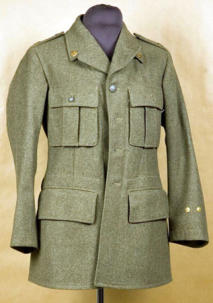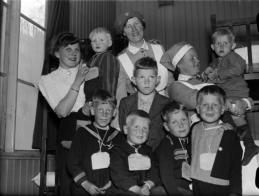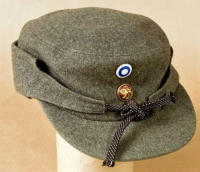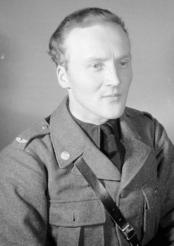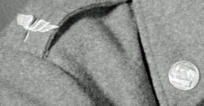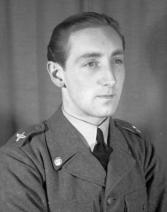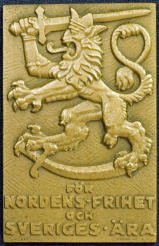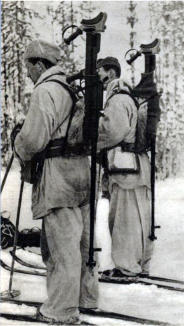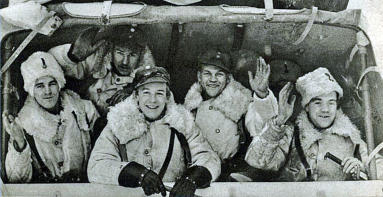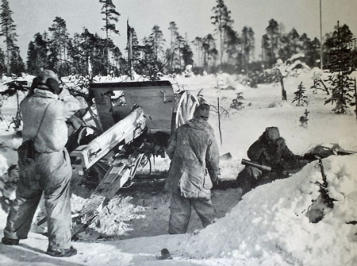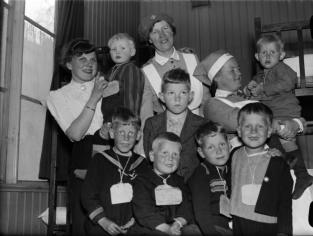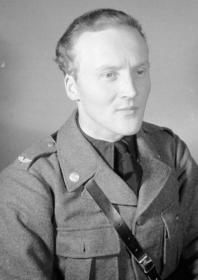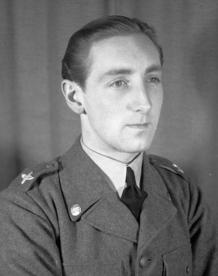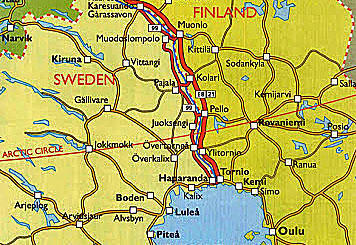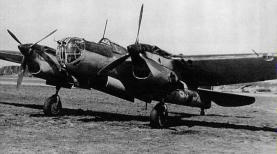

Copyright © Hans Högman 2021-01-19
The Swedish Volunteer
Corps in Finland - 1
The Finnish Winter War - WWII
The Winter War (Swe: Vinterkriget) was a war
between the Soviet Union (USSR) and Finland. It
began with the Soviet invasion of Finland on 30
November 1939, three months after the outbreak of
World War II, and ended three and a half months
later with the Moscow Peace Treaty on 12 March
1940 with a cease-fire at 11:00 on 13 March. Finland
ceded about 11% of its territory to the Soviet Union,
foremost the Karelia Isthmus.
Despite superior military strength, especially in tanks
and aircraft, the Soviet Union suffered severe losses
and initially made little headway. The signing of the
Molotov–Ribbentrop Pact gave the Soviets full freedom
of action in the Baltic Region and Finland.
In October 1939 the Soviets made several demands,
including that Finland cedes substantial border
territories in exchange for land elsewhere, claiming
security reasons—primarily the protection of
Leningrad, 32 km (20 mi) from the Finnish border.
When Finland refused, the USSR invaded.
Early morning on 30 November 1939 the Soviet
artillery opened fire into Finland followed by Soviet
infantry crossing the Finnish border on the Karelia
Isthmus. The Soviet forces were superior; both in the
number of soldiers and armament. At this point,
Finland’s armed forces consisted of 200,000 men, 32
tanks, and 119 aircraft. However, the Finns knew the
terrain better, were better adapted to war in Arctic
conditions and their units were able to operate more
independently.
When the Soviet Union attacked Finland on 30
November Sweden mobilized on December 2 an
Army division of 100,000 men to protect its north-
eastern border to Finland. On December 5 the
Swedish Navy began laying mines in the Åland Sea
between Sweden and Finland, east of Stockholm, to
keep Soviet submarines away from the Gulf of
Bothnia.
When World War II broke out, Sweden like many
other European countries declared themselves as
neutral states, among these states were also
Norway, Denmark, and Finland. When the Winter War
broke out Sweden changed its declaration to a non-
belligerent state. Thereby Sweden was able to help
and support Finland during the war without actively
participating in the war.
Being non-belligerent, the Swedish government
allowed the recruiting volunteers in Sweden. The
association Finland Committee (Swe:
Finlandskommittén) organized the enlistment of
volunteers in Sweden under the motto “Finland’s
Cause is Ours!” (Swe: Finlands sak är vår!).
In total, besides the military equipment supplied to
the Volunteer Corps, the Swedish government
handed over to Finland 131,000 rifles, 42 million
cartridges, 450 machine guns, 132 field artillery guns,
100 anti-aircraft guns, 85 anti-tank guns (including
256,000 grenades), and 8 military aircraft.
Sweden and Finland
Until 1809, Finland constituted the eastern part of the
Kingdom of Sweden. In the Swedish-Russo War 1808
- 1809, the Russian Empire conquered Finland and
converted it into an autonomous buffer state. The
resulting Grand Duchy of Finland enjoyed wide
autonomy within the Empire until the end of the 19th
century when Russia began attempts to assimilate
Finland as part of a general policy to strengthen the
central government and unify the Empire through
russification.
Swedish Volunteer Corps (SVC)
The Swedish Volunteers Corps (Swe: Svenska
Frivilligkåren, SFK) organized the Swedish citizens
who signed up as volunteers to fight in Finland with
the Finns in the Winter War 1939 - 1940, a war
between Finland and the USSR. The relations
between Finland and the Soviets had been very tense
for some time and even before the Soviet attack on
Finland on 30 November, there had been plans for a
Swedish volunteer force. On the day of the Soviet
attack, volunteer recruiting stations opened up at
several places in Sweden for the enlistment of
volunteers. At first, the Volunteers Corps wasn’t
allowed to advertise but that changed soon.
The Finland Committee in Sweden was the main body
for the organization of the Swedish Volunteer Corps.
In the evening of the day the Soviets attack on
Finland, Swedish Lieutenant Colonel C. A. Ehrensvärd
began the work of founding an organization for a
Swedish volunteer force. The Finland Committee was
constituted on 4 December 1939 in Stockholm.
On 12 December, the Finland Committee received all
the necessary permits from the Swedish government
to purchase needed military equipment and arms
from the Swedish Armed Forces.
Further, the Swedish draftees needed a leave of
absence from their units during WWII to go to
Finland. Also, the regular officers needed to be
granted a leave of absence. These requests were
accepted by the government too. Actually, the
officers had to resign with the right to re-enter their
positions when they returned from Finland.
The Finland Committee posted their first
advertisement for enlistments of volunteers on
December 13. On December 15
they published posters with the
motto “Finland’s Cause is
Ours!”. Also, fund-raising
schemes were initiated which
turnout was very large.
The image to the right shows
one of the posters used by the
Finland Committee. “Finlands
sak är vår” means “Finland’s
Cause is Ours!" and “Kom med i
Frivilligkåren” means “Join the Volunteer Corps”. The
skier to the left is wearing the Finnish flag on his
chest and the skier to the right, the Swedish flag.
Image: Army Museum.
The fund-raising for the Cause of Finland gave about
100 million Swedish Crowns which was a very large
amount then. These funds weren’t only financing the
Volunteer Corps. A large amount was also put to the
disposal of the government of Finland.
After only one month 125 volunteer recruiting
stations had been established in most parts of
Sweden. These recruiting stations signed up the
volunteers. After medical check-ups, vaccinations,
and other formalities were done each volunteer
received food coupons and a train ticket to the city of
Haparanda in northern Sweden, a Swedish-Finnish
border town. The first contingent of volunteers left
Stockholm Central Station for Haparanda on 21
December 1939.
The image to the left
shows a volunteer
recruiting office in
Stockholm. Image: Finland,
landet som kämpade.
Runeberg.
Once in Haparanda
(Sweden) and Torneå
(Finland) the military organization of the Volunteer
Corps took over the volunteers. When the volunteers
reported for duty in Torneå they had to sign a
contract with the government of Finland for war
service and it was now the volunteers received their
uniforms and personal military kit and arms.
This equipment and arms came from Swedish
military depots purchased by the Finland. Committee.
January 1940 was used for military training and field
exercises of the volunteers. This was done near the
city of Kemi in Finland, east of Haparanda. The
Commander of the Swedish Volunteer Corps,
General Linder, arrived in Torneå on 7 January 1940
together with his Chief of Staff Lieutenant Colonel
Ehrensvärd. The Swedish Volunteer Corps was
directly subordinated to the Supreme Commander of
the Finnish Armed Forces,
Field Marshal Gustaf
Mannerheim.
The image to the left shows
a group of Swedish
volunteers boarding a train
on their way to the front.
Image: Finland, landet som
kämpade. Runeberg.
The Swedish Volunteer Corps consisted of a
Headquarters with a headquarters company, Signal
Company, and three battlegroups (strengthened
battalions) supported by artillery and antitank units.
Each battlegroup consisted of a company
headquarters, a snowplow platoon, three infantry
rifle companies, a ranger company, a heavy company,
a military baggage unit, a 7 cm artillery battery, and
an army service unit. In total, each battlegroup
numbered about 1,600 men.
There were also anti-aircraft
units, army engineers, and
different supply units.
The image to the right shows
a ski-patrol with the Swedish
Volunteer Corps in Finland in
white ski-wear. The white ski-
wear worked as camouflage
in the snowy terrain. This
snow-camouflage made the
ski troops almost invisible.
Image: Wikipedia.
The Corps also consisted of an independent ranger
company, two motorized antitank platoons, an army
engineer company, an anti-aircraft company, two
motorized army service companies, a guard
company, two medical platoons, etc. The Corps also
included an Air Wing with 12 fighter aircraft and 4
light bombers.
Arms and military equipment were mainly purchased
from the Swedish Army. The cost of having the
Swedish Volunteer Corps fully operational was
covered by the fund-raising with the Swedish
population and the Swedish Industry.
The retired Swedish General Ernst Linder (1868 -
1943) was appointed Commander of the Corps.
General Linder had been a volunteer in Finland
during the Finnish Civil War in 1918. Linder was a
Major General in the Swedish Army and of Finland-
Swedish origin.
In total, 12.705 men applied to enroll with the
Swedish Volunteer Corps (727 of these were
Norwegians). Out of all the applicant volunteers,
8,260 Swedes were admitted and enrolled with
the Corps. However, there were about 9,500 Swedish
volunteers in Finland during the Winter War of which
8,260 served with the Swedish Volunteer Corps.
The enrolled Norwegian volunteers foremost served
in separate groups with the SVC but under the
command of Swedish officers since the Norwegian
government did not allow Norwegian officers to leave
Norway due to a shortage of officers in their army.
No other foreigners than Norwegians were admitted
into the Swedish Volunteer Corps. About 1,000 Danes
wished to enroll as volunteers with the SVC like many
from other countries. However, they had to serve in
Finnish volunteers units further south in Finland
since they were regarded as unable to fight in Arctic
conditions. For example, they lacked the necessary
skill in cross-country skiing and weren’t used to the
very cold temperatures and deep snow that existed
in the region the Corps was to operate in.
Depots for all the military equipment were organized
in Torneå and Kemi and it was here the volunteers
were dressed in uniform and armed. The different
units of the Corps were initially quartered in Kemi
and Karihaara. A military basic training of the men
now began. The military training and fitness
exercises, foremost skiing and field marches,
continued throughout January.
The Swedish Volunteers Corps arrived at the end of
February 1940 in the so-called Salla front sector.
Not all of the Swedish volunteers served with the
SVC. About 200 served with the artillery in Vasa, a full
hundred with the Åbo air defense, and another
hundred with the coastal defense in Pellinge. Circa
200 physicians and nurses had positions at military
and civilian hospitals. The Swedish
Red Cross had two ambulance units
and operated two base hospitals
and field hospitals and the Blue
Star operated an ambulance for
horses with veterinaries.
The image to the left shows two
Swedish soldiers in Finland during
the Winter War wearing white ski-
wear carrying antitank guns on
their backs.
Image: Wikipedia.
The image to
the right
shows
Swedish
volunteers on
their way to
the front on
the back of a
truck. Note
their white fur coats which were needed in the Arctic
climate. Image: Finland, landet som kämpade.
Runeberg.
Finland was finally forced to end the war. The
Moscow Peace Treaty was signed in Moscow on 12
March 1940. A cease-fire took effect the next day, 13
March, at 11:00 Helsinki time.
The Swedish Volunteer Corps remained on the alert
until the end of March. The disarmament of the
Corps began on 1 April and was completed about
three weeks later.
Of all the members of the Swedish Volunteer Corps,
38 men were killed, about 50 wounded in action and
over 130 were frostbitten.
On 26 March 1940 the Finnish Supreme Commander,
Field Marshal Gustaf Mannerheim (1867 - 1951),
officially thanked the members of the Swedish
Volunteer Corps in a ceremony at Paikanselkä, just
north of the former front-line.
More about the Swedish Volunteer Corps -
Operations and Organization
An Arctic Region
The Swedish Volunteer Corps (SVC) was inserted in
the Finnish part of Lapland, in order words, North
Finland. The territory the SVC was to fight in was on
the Arctic Circle with extremely cold temperatures in
winter, down to -45 C (-49 F), and with up to 1.5 m of
snow. The climate was a challenge to both men and
equipment during the Winter War. This region is a
vast wilderness, sparsely populated and mostly road-
less with hilly forestland and open mires.
The map to the
right shows both
northern
Sweden and
northern
Finland. The
Arctic Circle is
marked on the
map. The
Finnish town
Salla is located to the extreme right on the map, just
north of the Arctic Circle. The Salla front sector was
about 30 km (20 mi.) west of Salla. The Soviet
borderline is just east of Salla. The sea seen south of
Haparanda is the Gulf of Bothnia.
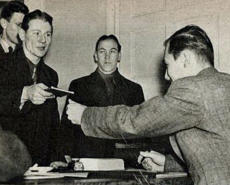
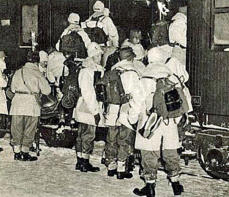
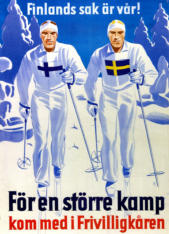
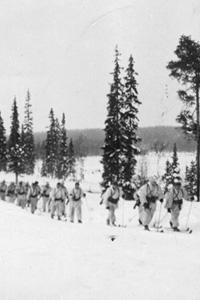
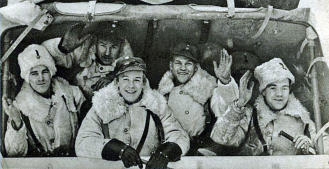
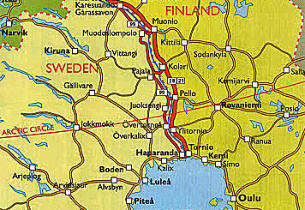
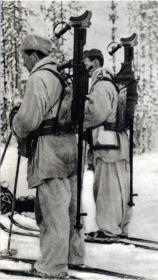
The Soviets drops bombs over
Sweden
Sweden and Swedish interests were also submitted
to acts of war during WWII. The Soviet bombing in
Norrbotten, North Sweden, in 1940 was most likely
an attempt to discourage Sweden from becoming
more involved in Finland during the Winter War.
Already at the outbreak of the Winter War on 30
November 1939 the Soviet Union, via diplomatic
channels, warned Sweden that “statements of
sympathy and relief actions for Finland might lead to
unwanted complications”. An early, and a very obvious
warning was the Soviet submarine SC-311:s firing on
the Swedish steamer Fenris on 5 January 1940, in the
Gulf of Bothnia, just south of Umeå at Sydostbrotten.
Aerial Bombing on the City of Luleå on 14
January 1940
The Swedish Volunteer Air Wing F 19 carried out their
first mission in Finland on 12 January 1940 when
they attacked Soviet troops and an airbase at
Märkäjärvi. During the air raid, two Swedish
bombers, two Hawker Hart, collided while avoiding
Soviet anti-aircraft firing, and the two pilots’, Sterner
and Jung, managed to bail out behind the Soviet
lines. However, they were later captured and taken
prisoners of war. Thereby it became obvious to the
Soviets that Sweden had flying combat units in
Finland. The Soviet retaliation came two days later.
On 14 January, three Soviet bombers, in a
snowstorm, dropped bombs over the city of Luleå.
However, due to Swedish anti-aircraft firing, the
Soviet aircraft came out of course dropped their
bombs on the island Kallax, just outside Luleå. There
were material damages but no people were injured.
The Soviet bombers might have failed in their
navigation and ended up in Sweden by mistake in the
bad weather, but the air route chosen indicates that
the target was a new Swedish air force airbase under
construction in Kallax. The construction began in
1939 and the airbase was opened in 1940.
During the Soviet bombers’ return flight they got into
trouble due to fuel shortage and had to make an
emergency landing in
Finland. The crew was taken
as prisoners of war and the
aircraft were ceded by the
Finns.
The map to the right shows
northern Sweden with both
Luleå and Pajala (encircled
in red).
Air Raid on Pajala town on 21 February 1940
On 21 February 1940, seven Soviet bombers
dropped about 150 bombs over Pajala, Norrbotten,
North Sweden. Six buildings were destroyed but no
casualties; two people were lightly injured. The
bombing raid began at 12:40 (noon) and in total 48
high-explosive bombs and about 100 incendiary
bombs were dropped, setting many buildings afire.
However, most of the bombs fell on the outskirts of
the small town which indicates that the Soviets
misjudged their altitude and the wind force. The
Soviet bombers had earlier been observed in Kengis,
closer to the Finnish border, so the people of Pajala
were warned about the approaching bombers and
were able to seek refuge outdoors or in basements,
etc. After the air raid, the people of Pajala began
putting out the fires caused by the bombs, to their
best ability. There was no fire-brigade in Pajala in
1940. Several bombs fell near the town church. The
church survived besides broken windows, smashed
by the shock waves. The Soviet bomber aircraft was
probably the twin-engined Tupolev SB-2 and Iljushin
DB-3.
The image to the
right shows the
homestead of Sven
Westerberg in
Pajala burning
down after being
hit by a Soviet
incendiary bomb.
Image: Wikipedia.
Later on the same day, over Rovaniemi, a pair of
Swedish fighter aircraft with the F 19 Swedish
Volunteer Air Wing in Finland made eye-contact with
a group av Soviet bombers consisting of three SB-2
and seven DB-3 from Soviet 5. OSAP.
The two Swedish fighters, Gloster Gladiators, with
pilots’ Carl-Olof Steninger respectively Arne Frykholm
immediately charged the Soviet bombers. Together
they shot down an SB bomber. Steninger also
damaged one of the DB-3 bombers. Further, the two
Swedish fighters winged another DB-3 that forced
landed near Sikakoski in Finland. The DB-3 bombers
normally carried o crew of four, however, this one
only had three.
The three Soviet members of the crew tried to escape
on skis but were captured by Finnish ground troops.
The Russian air gunner was killed when he tried to
escape. It turned out that this bomber was one of
the bombers that dropped bombs over Pajala in
Sweden earlier that day.
The image to the left
shows the Soviet
bomber aircraft
Tupolev ANT-40/TB-
SB. This one is a
Soviet bomber that
was captured by the
Finns after it made
an emergency landing in Finland during the war.
Image: Wikipedia.
Sweden made a formal but vigorous diplomatic
protest to the Soviet Union on the same day. At first,
the Soviets denied that they had dropped bombs
over Pajala. “A malicious fabrication” they called it.
However, on 6 March they acknowledged that a
group of Soviet bombers had got lost during an air
raid in Finland. This was the only bombing over
Sweden the Soviet government acknowledged during
WWII. Soviet officers later inspected the damages
done to Pajala and the Soviet government paid
40,000 SEK in damages.
Soviet Submarines
During 1942 the Swedish Navy fought an unofficial,
but very real war with Soviet submarines in the
Baltic Sea, submarines that had been attacking and
destroying Swedish merchant ships. A few hundred
Nazi Germans and an unknown number of Soviet
soldiers and seamen were killed during these anti-
submarine activities carried out by the Swedish Navy.
Further, on 13 occasions Sweden was being bombed
by air raids.
Air Raids on Stockholm and Strängnäs in
1944
During the evening and night on 22 - 23 February
1944 East Central Sweden was being bombed by the
Soviets. Several places in and near Stockholm were
hit. Two other cities in the vicinity of Stockholm was
also bombed, Strängnäs and Södertälje.
There were no casualties, but two people were
injured in Stockholm. Around nine o’clock in the
evening on 22 February 1944, four bombs were
dropped over the Eriksdalslunden Park in
Södermalm district, downtown Stockholm. In the
park was a new outdoor theater that was destroyed
by the bombs. Bombs were also dropped over several
inhabited islands in the Stockholm archipelago.
The air defense warning service identified six
formations of enemy aircraft of at least one aircraft
per formation. Sweden had no radar warning
systems in 1944. The first formation of bombers
headed for Strängnäs and arrived about 14 minutes
before the third formation which attacked Stockholm.
Only three formations flew in over the Swedish
mainland.
Strängnäs is a city west of Stockholm and the location
of the Södermanland Armored Tank Regiment. The
Soviet bombers dropped their cargo of bombs over
and near the garrison. Thousands of windows were
broken in the barracks but there were also other
material damages. To soldiers were injured by shell
splinters.
The image to the
right shows trees
in the Eriksdal
Park, Stockholm,
damaged by the
bombing on 22
February 1944.
Photo: Lennart af
Petersens (1913-
2004). Stockholms
stadsmuseum,
Image-ID:
SSMF034063.
The incident brought about a formal diplomatic
protest by Sweden in Moscow, the following day. The
Soviet standpoint was clear. Moscow declared that
not a single Soviet plane flew over Stockholm or over
Swedish territory in general. Shrapnel with Cyrillic
letters found in Stockholm and Strängnäs didn’t
originate from Soviet bombs, according to Moscow.
The traditional Moscow manner of explaining away
almost anything, still very familiar today.
Brittish Aircraft Drops Bombs over Sweden
Even British bombers made navigational errors
during air missions.
Early morning on 3 October 1940 a British bomber,
an Armstrong Whitworth Whitley, dropped three
bombs over Malmö City, Skåne, South Sweden. The
explosions didn’t cause only minor damages to a few
nearby houses. London denied having dropped the
bombs. However, convincing evidence forced the
British to acknowledge the dropped bombs. The air
raid was supposed to be intended on the city of
Stettin in Nazi Germany.
At 21:10 on 18 November 1943, a British bomber
dropped explosive bombs and a few incendiary
bombs over the city of Lund, Skåne. Two bombs
destroyed an electric transformer station. The aircraft
thereafter turned south and flew over Ystad city
where it was fired at by Swedish anti-aircraft
batteries. It was regarded to be a British bomber on
its way home to England from a mission in Germany
when it dropped its remaining bombs. The aircraft
was an Avro Lancaster which at this time was used
for night bombing over Berlin.
On 4 April 1945, a British aircraft attacked a Swedish
train by mistake in Bohuslän on the Swedish west
coast. The real target was a train in occupied Norway.
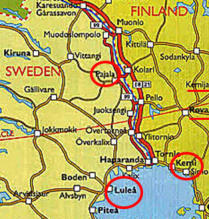
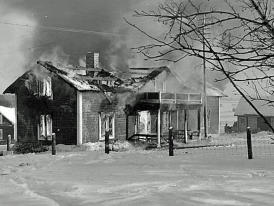
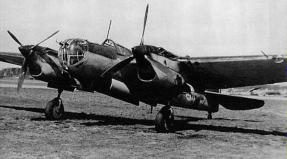
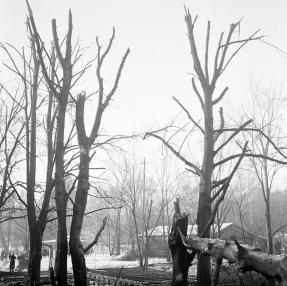
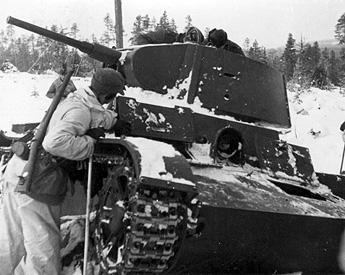
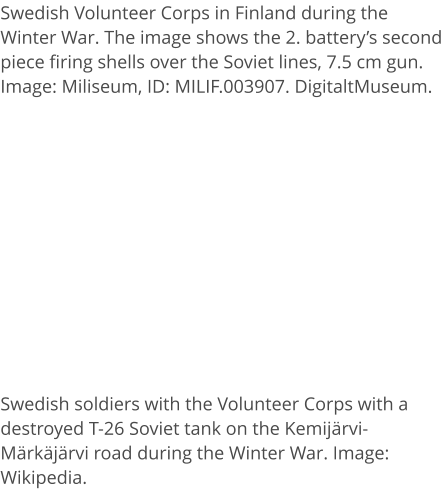
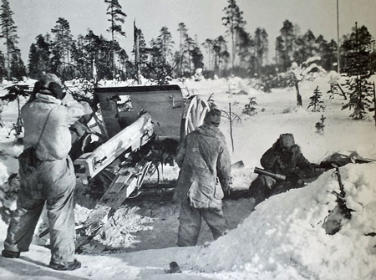
Other Swedish Volunteer Units in
Finland during the Winter War
Besides the Swedish Volunteer Corps, there were
other Swedish military units in Finland during the
Winter War. The Swedish Artillery had a volunteer
unit in Finland. The volunteer artillery force had a
base in the city of Vasa in Österbotten with Swedish
artillery volunteers. The artillery unit consisted of 30
officers and 200 artillerymen.
During the Winter War, the City of Åbo purchased
nine 7.5 cm m/1930 anti-aircraft guns from Sweden.
Further, about 40 volunteer seamen from the
Swedish Navy served with a Finnish anti-aircraft
battery located on an island outside the city.
The Continuation War 1941 - 1944
The Continuation War (Swe: Fortsättningskriget) was
a conflict fought by Finland and Nazi Germany,
against the Soviet Union (USSR) between 25 June
1941 and 19 September 1944, during World War II.
Germany regarded its operations in the region as
part of its overall war efforts on the Eastern Front
and provided Finland with critical material support
and military assistance, including economic aid.
There have been numerous reasons proposed for the
Finnish decision to invade the USSR, with regaining
territory lost during the Winter War being regarded
as the most common including the desire to retake
Karelia. However, after the war, Finland was required
to return to the borders agreed to in the 1940
Moscow Peace Treaty and demobilize its armed
forces.
The Finnish Army implemented a ceasefire at 8:00
a.m. Helsinki time on 4 September 1944; the Red
Army followed suit a day later. The Peace Treaty was
signed in Moscow on September 19, 1944.
After the Winter War, Finland was in a state of
emergency. Sooner or later they had to choose
between Nazi Germany or the USSR. Germany
planned an assault on the USSR and needed Finnish
territory in the attack, especially Finnish Lapland. The
Germans began negotiations with the Finns at the
end of 1940. The Finns saw this as an opportunity to
retake lost territories. German troops arrived in
Finland at the beginning of 1941 and eventually
numbered 200,000 soldiers. In May 1941 the Finnish
parliament decided to join the Germans in the
invasion on the USSR. The attack of USSR, Operation
Barbarossa, was launched on 22 June 1941.
Less Swedish Volunteers in the Continuation
War - Swedish Volunteer Battalion
The Continuation War didn’t attract as many Swedish
volunteers as the Winter War. The Finnish
collaboration with Nazi Germany was one reason.
Further, the Winter War was a Finnish defensive war
while the Continuation War was offensive. However,
about 2.800 Swedish volunteers signed up and
about 800 of these served in the so-called Swedish
Volunteer Battalion (Swe: Svenska
frivilligbattaljonen) on the Hangö front during the
summer and fall of 1941.
The Swedish battalion participated in the liberation
of Hangö on 4 December 1941. The Swedish unit lost
26 men and about 80 wounded. After the liberation
of Hangö, the battalion was phased out and the
volunteers returned to Sweden.
Swedish Volunteers in the Svir Company
At the beginning of 1942 yet another Swedish
volunteer force was organized, the so-called Svir
Company (Swe: Svirkompaniet). The unit was
deployed to the Svir front between Lake Ladoga and
Onega. The Swedes fought here in a positional war
for two years. Thereafter they participated in the
dreadful preventive war on the Karelia Isthmus
during the summer of 1944. When the company was
disestablished in Åbo on 16 September 1944, the
company counted 35 dead Swedish soldiers.
Further, a few hundred Swedes also fought in the two
Finland Swedish regiments (Finnish regiments with
Swedish speaking Finns).
Swedish F 19 Air Force Wing in
Finland
The Swedish Volunteer Air Wing in Finland or F 19
Finland was a Swedish volunteer flying unit forming
an air wing in 1940 in Finland during the Winter War.
At the outbreak of the Winter War, the Finnish Air
Force was small with only 114 combat planes fit for
duty and were mainly used to repel Soviet bombers.
To reinforce the Finnish Air Force the Swedish
government on 8 December 1939 handed over 8
fighter aircraft to Finland; three Swedish Jaktfalk J 6,
three reconnaissance aircraft Fokker CV-E S 6, and
two Bristol Bulldog J 7. These aircraft were inserted
into the Finnish Air Force who now concentrated
their air defense in southern Finland.
To help Finland, the Swedish Air Staff began
preparations to raise a volunteer flying unit with a
fighter aircraft group and a bomber group to be
used in North Finland with the Swedish Volunteer
Corps.
On 14 December 1939, the Swedish government
gave the green light to a Swedish volunteer flying
unit. Commander of the Volunteer Air Force Wing
was Major Hugo Beckhammar, who already in
December 1939 recruited 240 volunteer airmen
(ground crew and pilots), who at the end of
December went to Kemi in North Finland to prepare
an airbase in Veitsiluoto.
On 30 December, the government ruled that
combat planes were to be put to the disposal of
the volunteer air wing; four bombers B 4 Hawker
Hart, and twelve fighter aircraft J 8 Gloster
Gladiator. At this point, at the beginning of WWII,
these twelve fighter aircraft represented a third of
the Swedish fleet of fighter aircraft. However, the
Swedish Air Force had an order of a large number of
modern fighter aircraft coming, so it was possible to
give these older biplane Gloster Gladiators to
Finland.
The Swedish Volunteer Air Wing fought in Finland
with the Finnish national markings on the planes.
The air wing’s mission was to pursue reconnaissance
and attacks on Soviet airbases and ground troops.
The image to the left shows No
873 Second Lieutenant Ian Iacobi
(1916 - 2008), a fighter pilot with
F 19, the Swedish Volunteer Air
Wing in Finland during the Winter
War 1940. On his shoulder straps
is his air force pilot wings visible.
Photo: Karl Johan Åke
Sundström. Image:
Flygvapenmuseum, ID:
FVMF.004280. DigitaltMuseum.
On 12 January 1940 Second Lieutenant Ian Iacobi
became the first Swedish pilot with the F 19 Air Wing
to shot down an enemy aircraft in aerial combat, a
Russian Polikarpov I-15.
The F 19 Air Wing was organized with a Wing
Headquarters, a fighter group, a light bomber group,
an air transportation group, and an airbase
company, in total 250 men and two women.
On 8 January the Swedish Air Wing reached an
agreement with the Finnish authorities to adopt the
name "19. Air Force Wing (F 19)" while the Finns
would use the name "Flight Regiment 5", in Finnish:
”Lento R 5” for the Swedish air wing.
On 10 January the Swedish aircraft arrived from
Sweden and two days later the flying unit relieved a
hard-pressed Finnish army group that held a
position at Joutsijärvi despite repeatedly intense
Russian attacks.
During January five advanced airbases were
constructed closer to the front-line. Preparations
were also initiated to transfer a Swedish bomber
group with the heavy bomber aircraft B 3 (Junkers
Ju 86) to F 19 but the war was ended before these
aircraft arrived.
When the armistice took effect on 13 March 1940,
the F 19 had been carrying out flight missions for 62
days, which resulted in twelve destroyed Soviet
aircraft but also the loss of 6 own aircraft, and three
killed Swedish pilots. Nine
Gloster Gladiators J 8 and two
Hawker Hart B 4 returned to
Sweden at the end of March
1940 where they resumed
service.
The image to the right shows No
858 Sergeant Thure Hansson,
air gunner with the Swedish
Volunteer Air Wing in Finland
during the Winter War, 1940. On
his shoulder straps is his air force aircrew wings
visible, two wings. On his collar is the insignia of the
Swedish Volunteer Corps
attached, four hands (see left
image). Photo: Karl Johan Åke
Sundström. Image:
Flygvapenmuseum, ID:
FVMF.004290. DigitaltMuseum.
The Swedish term for Air Wing is “Flygflottilj” (literal
meaning is Air Flotilla or Flight Flotilla) and the unit
designation for the Swedish Air Wings is “F”
followed by each unit’s serial number, for example, F
19.
The airmen of the F 19 Air Wing in Finland wore,
besides their flying-suits, the same uniform as the
ground troops with the Swedish Volunteer Corps,
the Swedish Army uniform m/1939 (see below).
The majority of the Swedish fighter pilots were
recruited from the Svea Air Wing F8 (Svea flygflottilj
F 8) in Barkaby, Stockholm, while the bombers came
from Jämtland Air Wing F 4 (Jämtlands flygflottilj F 4)
in Frösön, Östersund.
More about the Swedish F 19 Air Wing - Flight
Missions and Aircraft.
The Uniform of the Swedish
Volunteer Corps
The soldiers of the Swedish Volunteer Corps in
Finland were equipped with the Swedish Army’s
battle dress uniform m/1939. However, some
modifications were made; the Swedish buttons
were removed and replaced with the Finnish type of
buttons with the Finnish Lion imprinted instead of
the Swedish Three Crowns. The Corps insignia of
the Swedish Volunteer Corps was worn on the
collars. The different unit’s insignias of the Corps
were worn on the shoulder straps.
The headgears were equipped with the Finnish
military nationality insignia.
The rank insignias were worn at the bottom of the
sleeves according to Finnish traditions. Officers wore
Finnish rank insignias consisting of golden marks of
roses while NCOs wore silver roses and other ranks
silver stripes.
The image to the right
shows coat m/1939 which
was used by the Swedish
Volunteer Corps in Finland.
On each shoulder strap of
this particular coat is a
round brass plate showing
an imprinted crossbow
which was the unit insignia
for the First Battle Group.
The collar holds the
insignia of the Volunteer
Corps; four hands holding
each other. At the bottom of each sleeve is the rank
insignia; 2 golden roses which are the rank of
Lieutenant. The coats buttons are made of metal
with the Finnish Lion imprinted. Image:
Armémuseum, ID: AM.020073. DigitaltMuseum.
This particular coat was worn by a Swedish officer in
the Swedish Volunteer Corps in Finland during the
Winter War, Lieutenant Melcher Wase Bo Gustaf
Wernstedt, b. 1909.
Wernstedt was enlisted with the Volunteer Corps
on 26 December 1939 and was assigned to the First
Battle Group under the command of Lieutenant
Colonel Magnus Dyrssen.
The image to the right shows
the skiing cap. Below the
blue and white nationality
insignia is a button with the
Finnish Lion. Image:
Armémuseum, ID:
AM.104313. DigitaltMuseum.
The Swedish uniform m/1939 was when it was
distributed to the Swedish Volunteer Corps, a brand
new uniform model. Then, the uniform wasn’t yet
distributed to the Swedish Army.
See also the Uniform of the Swedish Volunteer
Corps.
Summary
To support Finland, the Swedish government
handed over a lot of military arms to the Finnish
armed forces. Besides the arms to the Swedish
Volunteer Corps, Finland received from Swedish
Army depots among others; 131,000 rifles with 42
million cartridges, 132 artillery field guns, 100 anti-
aircraft guns, 85 anti-tank guns with 256,000
grenades, and 8 combat aircraft.
Finland needed to take delivery of large quantities of
military equipment during the Winter War and at the
same time be able to export Finnish produce, for
example, paper and paper pulp. In the Baltic Sea,
Soviet submarines lurked. Transportation of goods
on the railroad line between Finland and Sweden via
Torneå in Finland and Haparanda in Sweden
couldn’t swallow the large quantities needed.
The Gulf of Bothnia was frozen, so an ice-road
between Vasa in Finland and Umeå in Sweden was
prepared across the sea at the so-called “Kvarken”,
where Swedish and Finnish trucks in cold weather
and total darkness during nights (to avoid Soviet
bombers) transported very large quantities of
freight to and from Finland. This ice-road was a
lifeline for Finland and the Finns called it the “Milky
Way” (Swe: Vintergatan).
All volunteers in the Swedish
Volunteer Corps in Finland during
the Winter War have been
conferred a distinction, a plaque.
See the image to the right.
The front of the plaque has the
Finnish Lion imprinted and the
text "FÖR NORDENS FRIHET OCH
SVERIGES ÄRA" (For the Freedom
of the Nordic and the Honor of
Sweden). The back of the plaque
holds the text "SVENSKA FRIVILLIGKÅREN
KRIGSTJÄNST I FINLAND 1940" In Service with the
Swedish Volunteer Corps in Finland 1940). Image:
Armémuseum, ID: AM.019223.
Cold Winters during the War
There were three extremely cold winters in Northern
Europe during WWII; they were the winters of
1939/1940, 1940/1941, and 1941/1942.
The winter of 1939/1940 was very cold in the entire
of Sweden with deep snow. This winter was the
fourth or fifth coldest winter ever in the 20th
century. However, in Vilhelmina, North Sweden, the
thermometer dropped down to −53 °C (-63 F) on 13
December 1941.
North Finland had the same very cold winter in
1939/1940. As we can see in the photos above, the
soldiers are well wrapped-up.
Refugee Children from Finland
During the Winter War of 1939 – 1940 and the
Continuation War 1941 – 1944 about 70,000 Finnish
children were sent to the other Scandinavian
countries, foremost to Sweden. About 10,000 of
these children were adopted by their Swedish
families.
The image to the
right shows Finnish
refugee children
being taken care of
by Swedish Red Cross
nurses in Uppsala,
Sweden, in May 1942.
Image:
Upplandsmuseet, ID:
PS10592. DigitaltMuseum.
Peace Treaty
On 7 March 1940 Finnish Prime Minister Ryti arrived
in Moscow with a negotiation team. The Finns had to
accept the Soviet terms and among other territories
cede the Karelia Isthmus. The Peace Treaty was
signed on 12 March 1940 with a cease-fire at 11:00
on 13 March. (Helsinki time). Finland ceded about
11% of its territory to the Soviet Union.
